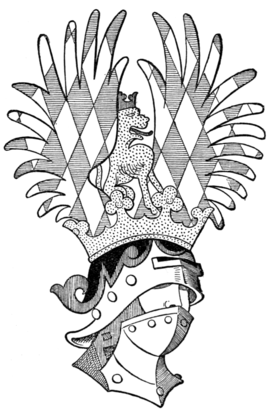visor, is very seldom seen in heraldic use. An instance, however, in which it has been made use of heraldically will be found in Fig. 598, which is from a pen and ink drawing in the Fest-Buch of Paulus Kel, a MS. now in the Royal Library at Munich. This shows the schallern with the slit for seeing through, and the fixed neck-guard. The "bart," "bavière," or beaver, for the protection of the under part of the face, is also visible. It is not joined to the helmet. The helmet bears the crest of Bavaria, the red-crowned golden lion of the Palatinate within the wings of the curiously disposed Bavarian tinctures. Fig. 599 (p. 316) is a very good representation of a schallern dating from the latter part of the fifteenth century, with a sliding neck-guard. It is reproduced from the Deutscher Herold, 1892, No. 2.

Fig. 598.—Schallern, with Crest of Bavaria (Duke Ludwig of Bavaria, 1449).
Until almost the middle of the fifteenth century all helmets fitted on the top of the head, or were put right over; but about 1440 the Italians made a great improvement by inventing the "armet," the lower part of which opened out with hinges, so that when put on it enclosed the head, fitting closely round the lower part of it, while its weight was borne by the steel collar, or "gorget." The Italian armet had a roundel or disc to protect the opening at the back of the neck, and a bavier strapped on in front to cover the joining of the two
